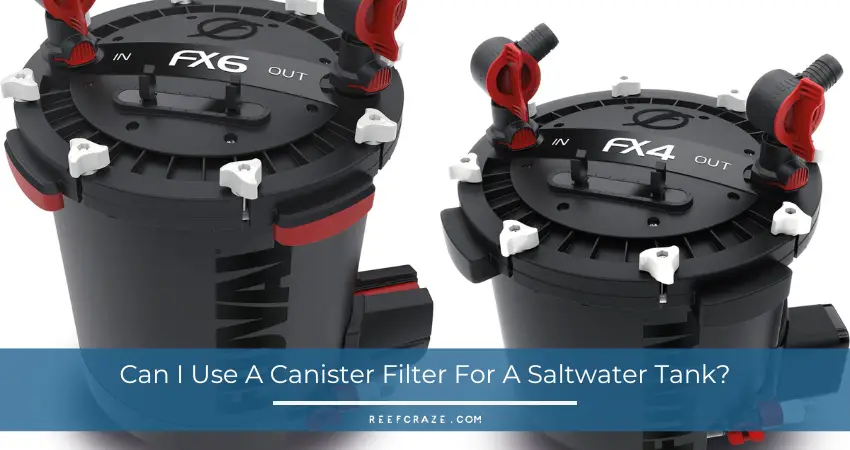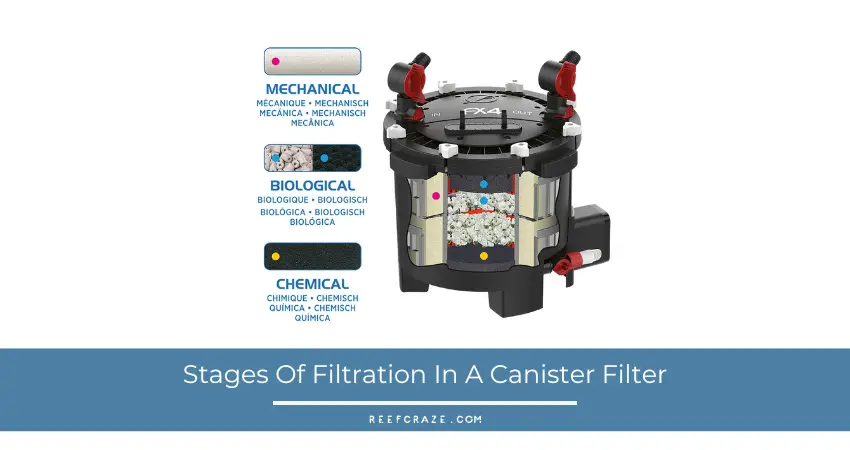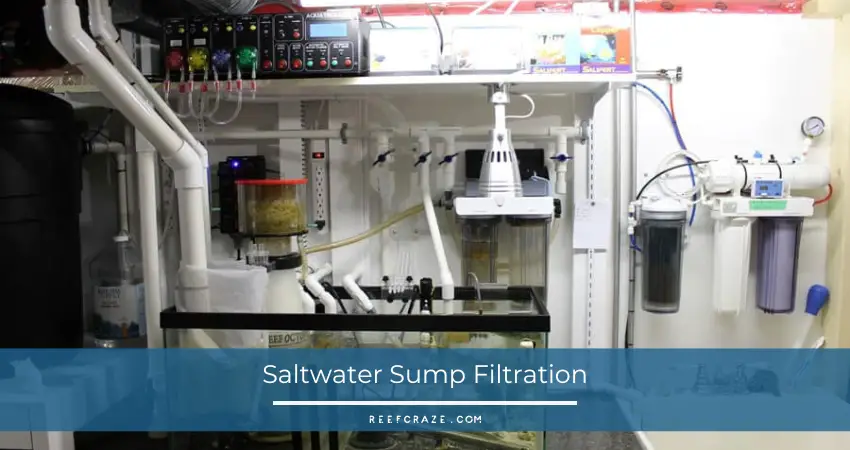Canister filters are considered top-of-the-line filtration systems for freshwater tanks. They are silent, have up to 3 mediums of filtration packed into a single system, and can handle large water tanks easily. These seem to be the perfect qualities for a saltwater tank, but is it safe for you to do so?
A canister filter can be used for a saltwater tank, but it will require extensive expertise and regular, arduous maintenance. If you don’t maintain the filter regularly, then you have to deal with nitrate buildup and filter clogging. It’s better to go for a sump for a more self-maintaining and resilient filtration system.
To help you understand how a canister filter works in a saltwater tank, I’ll talk about how canister filters work and their benefits. I’ll conclude by discussing how it interacts with a saltwater tank and how it measures up to traditional sumps.

How Does A Canister Filter Work?
A canister filter is a multi-layer external filtration system that can remove particulates, germs, and toxins from tank water. Canister filters use a pump and siphon pipes to cycle water through filters within the main chamber. As the filter uses gravity and surface tension to its advantage, it doesn’t require strong motors to function.
The canister filter contains multiple filters and a motor within the main chamber. After rushing through the intake pipe, the water encounters a mechanical filter. Typical filters of this variant are made of bio-glass. These are small cylindrical filters that have pores capable of blocking large debris.

The second filter is a chemical medium, which has a wider selection to choose from. The most popular of these is the activated carbon filter. It can remove harmful compounds such as copper salts and chlorine from the water. Activated carbon filters are good for removing excess medicine and changing the water color to normal.
The third filter is a biological filter that is considered optional. It can be another layer of bio-glass or extremely porous ceramic. In both cases, the filter provides a generous surface area for bacteria to form on them. These filters help reduce ammonia in the water but do not reduce the water flow through the pipes.
The first filter can serve as the biological filter for many cases, so the third filter is rarely used. Once the water has been filtered, a siphoning outflow pipe returns the water to the tank.
Read More:
What Are the Benefits? And Are There Any Issues?
Canister filters are well-liked because of how thoroughly they cleanse the water in freshwater tanks. However, these filters also provide the following benefits.
- Canister filters remove impurities from water in 2 or more layers. This allows the filter to remove germs, toxins, and debris with higher efficiency than most other filters.
- Canister filters operate quietly, as they rely more on natural forces to cycle the water. Unlike HOB filters, these hardly make a sound. The lack of noise makes it a good option to avoid stressing the fish out.
- Canister filters require very little power to operate. Using natural forces reduces the work the pump in the main chamber has to do.
- These filters can handle larger tanks, unlike most HOB filters. The filtration system can move large volumes of water without slowing down or affecting the filters’ performance.
- Because they are external filters, canister filters can be attached to and removed from the tanks easily.
There are mostly 2 key issues that come up when using canister filters.
- Maintenance of canister filters is a critical issue. Canister filters require regular and extensive maintenance efforts. If you leave a canister filter unattended, it doesn’t take too long for it to become useless.
- Canister filters require expert knowledge to maintain. You have to be able to dismantle and reassemble the main chamber of the filter to maintain it.
- Canister filters are quite costly. Unlike HOB filters, a decent canister filter will cost over $100, and quality filters can cost more than $150.
- Each layer of the filter has different cleaning procedures, adding to the complexity.
A canister filter is a case of precision having a price. You get a silent, powerful, and low-wattage filter for frequent and exhaustive maintenance. But is this tradeoff worth it for a saltwater tank?
Canister Filters And Saltwater Tanks
On paper, a canister filter should be the perfect filtration system for a saltwater tank. The filter’s ability to provide multiple types of filtration for large bodies of water and its silent operation makes it an ideal prospect for handling saltwater tanks.
Unfortunately, the filter’s issues become more prominent if it is used for saltwater tanks. You’ll encounter these 4 issues.
- Nitrate buildup.
- Rapid clogging.
- Frequent maintenance.
- Lower flow rate.
Nitrate Buildup
This is an issue that occurs when freshwater canister filters are ignored for a while. As the filter catches detritus and debris, the buildup rots and produces nitrites and nitrates. This mixes with the water during filtration and increases the acidity and toxicity of the water.
Unfortunately, this process takes place in saltwater canister filters much faster. This nitrate factory within the filter can lower your saltwater tank’s pH levels after filtration and increase nitrite and nitrate levels above 5 ppm. Your tanks will become swamped with algae under these conditions, and your fish will encounter a hostile, acidic, and toxic environment.
Rapid Clogging
While canister filters are meant to tackle larger bodies of water, they aren’t meant for the environment that saltwater tanks have. Canister filters show proficiency in removing detritus and debris and removing algae, amphipod, and copepod larval blooms under optimum conditions. But this clogs up the filter far faster than it would in a freshwater tank.
As the filter clogs up, it reintroduces many of the harmful substances it filters back into the water. The filter gets choked up and fails to cycle water at an ideal rate. Eventually, the mechanism itself will be affected, and the pump will break down.
Frequent Maintenance
Due to the rapid nitrate and nitrite buildup, along with physical debris blocking the filters, you’ll have to maintain the filter more frequently. If you use the filter as the sole filtration system for your tank, then you’ll be removing it every so often and leaving your tank vulnerable for the duration. The filters will need replacing too often and increase the cost noticeably.
You’ll have to dismantle, clean, and replace filter mediums, siphon pipes, and the pump deftly and swiftly. The filter mediums can be delicate to handle, especially the biological ones. This process becomes mentally taxing with such frequency, and robs you of your time and effort.
Low Flow Rate
Even without the blockage issues, canister filters will have a lower flow rate in saltwater tanks. As the water is saturated with salt, minerals, and other chemicals, it takes more effort to process. With the clogging issue, the filter’s flow rate will keep lowering too fast and slow down the filtration process enough to cause toxin and debris formation in the tank water.
Using a canister filter as the sole filtration mechanism for a saltwater tank is far from ideal. It’d take too much effort to maintain, and you’d leave your tank vulnerable while you work on the filter. Adding another method of filtration, such as live rocks, would increase its performance drastically. But even with additional biological filters, it cannot measure up to a sump.
Canister Filters Vs Sumps

With additional filtration methods, a canister filter won’t need maintenance more than once a month. But it still cannot measure up to sumps in performance or resilience.
Sumps contain different units dedicated to mechanical, chemical, and biological filtration, with bigger filters and functions such as protein skimming, pH stabilization, and food provision. A sump can include a refugium, which will provide food for the fish and also breed algae and other plant forms that control and keep pH, KH, and toxic levels stable.
Wrapping Up
You can use canister filters for saltwater tanks, but at a cost that you don’t want to pay. The effort to manage your tank and the lack of functionality will keep you worried and drain your energy. So, unless you have a canister filter lying around, go the extra mile and get a sump for your tank.
